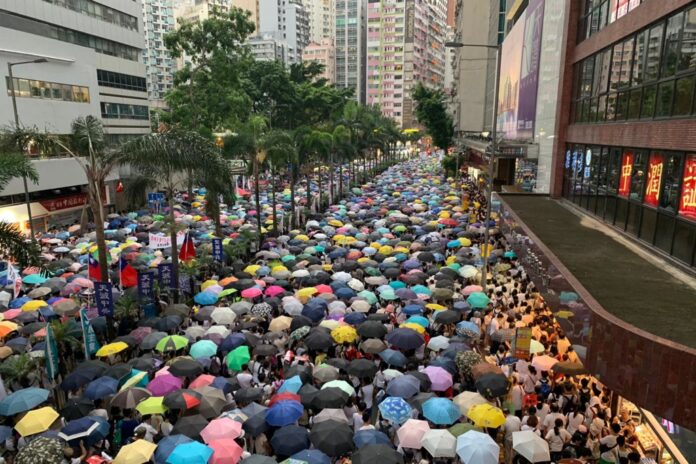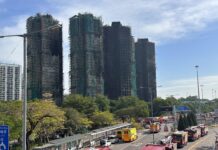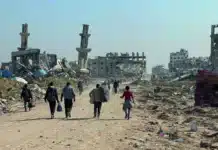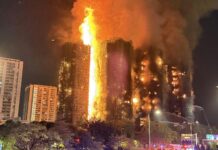These were the biggest demonstrations in Hong Kong history, with one in four people going onto the street
Jo Yan, Socialist Action
The struggle which began in June 2019 was a magnificent mass movement. It included the first political strike in Hong Kong for 90 years. The repression was extremely brutal, with one in seven people suffering the taste of tear gas and over 10,000 arrested. But the police violence enraged people and the movement lasted for more than half a year.
However, no democratic rights or concessions were won by the movement. Today, the same Carrie Lam government is still in power. With the national security law passed, Hong Kong is now in a stage of total counterrevolution. Opposition leaders may be jailed for more than ten years, and all anti-government protests are banned. There is no opposition media in Hong Kong now – all are pro-CCP and capitalist. Many political parties and groups will cease to exist or have to go underground.
Movement lacks politics
The most active force in the struggle was youth who unfortunately did not have an independent political programme from the liberal pan-democrats. The main idea was only to defend Hong Kong as one city, but neglecting the mass struggle in mainland China without which it is impossible to overthrow the dictatorship. The starting point of mass consciousness was that the CCP should keep its promise of ‘one country, two systems’ – to allow autonomy in Hong Kong. Autonomy means being the only city in China with certain democratic rights: to vote in elections, to demonstrate, set up political parties and conduct open political activity.
However, with rising mass discontent in China and also intense pressure from the US-China imperialist power struggle, the CCP cannot be seen to make any political concessions. It must viciously attack democratic rights in Hong Kong to demonstrate its authority and incite nationalism against “foreign ideas”.
All these complex matters were not discussed at all because politics were not seen as important in the movement; there were no mass meetings or committees to speak and call for a vote on important decisions. It was thought that if enough pressure was built on the streets the government would have to make concessions, which is not true in this case. Under a war-like confrontation between protestors and police, the whole focus of youth protestors became action – how to confront police and block transport. The main discussions in the protest movement were about tactics and hardware, including which equipment like gas masks and helmets are best against tear gas. Alternatively, it was about which road or transport link to block as the most effective way to paralyse the city.
Discussing basic political ideas was extremely hard to get through to the youth audience due to this consciousness. Socialist Action was a very active force in the movement. No other left group intervened as an organised force (some did as individuals only). The focus on action meant that most protestors coming to our banner or stall would donate to us but then leave immediately. If we tried to grab them to discuss more, the most common response would be, “I already know everything”.
No matter how militant the youth protestors were – and their courage was astounding – even though the Hong Kong government was completely paralysed during July-September 2019, there was no programme to spread the movement to China to bring down the dictatorship, also no working class action i.e. organisation, strikes, mass meetings, to challenge the capitalist economy. With the support of the CCP dictatorship, the Hong Kong government got the time it needed to recover and reconsolidate its power.
Chinese masses
The main programme of socialists was to unite with the mainland Chinese masses in a common struggle. The demands of the Hong Kong movement needed to be expanded to attract the mainland Chinese masses. The main five demands were only about Hong Kong bourgeois democratic rights. They were important, we support them. But they did not raise the need to overthrow the CCP dictatorship. They were limited to the idea of getting “real autonomy” for Hong Kong. Socialists argued the demands must include an end to dictatorship, against censorship, for feminist rights, an 8-hour working day, trade union rights (unions are banned in China), etc.
The movement must also challenge capitalism because all the big capitalists in Hong Kong and China are 100 percent the supporters of the CCP. That’s why an organised working class with strike action is the key to escalate the movement. The movement must have economic demands to mobilise the working class, including affordable public housing, a universal pensions system and public ownership and democratic control of the economy. There was a strong sense of unity. A main slogan in the protest movement was “no split”. The bitter experience in the 2014 Umbrella Movement was that different political organisations, mainly localist organisations, engaged in sectarian infighting which sapped energy and caused a split. The movement in 2019 wanted to avoid this, wanted unity against the CCP, but wrongly adopted the method of discouraging debate. Under the slogan “no split”, there developed a conscious pressure to avoid political discussions; criticism would meet a hostile response.
Anti-party, anti-politician
As the struggle developed, the liberal pan-democrats stressed they stood for peaceful methods; the youth were for confronting the police; but the idea was spread that “both methods are legitimate” and no side should criticise the other. This meant the movement actually lost direction without any collective decision-making and evaluation of what are the best methods to build and go forward. Neither the “peaceful” or the “courageous” method was correct, because they were not linked to a political way forward, a clear program.
The anti-party mood at the beginning of the movement played a certain progressive role. There is a strong distrust of the liberal pan-democratic parties, which have a history of rotten compromise with the dictatorship and political betrayals. the CCP as a dictatorship will never make concessions to democratic rights unless it faces mass revolutionary upheavals and its rule is threatened in China.
Over the previous 20 years, the democracy struggle in Hong Kong was led by pan-democrats, who limited the movement to one-off demonstrations. The youth felt the pan-democrats are too soft and that it was necessary to adopt a more militant, confrontational approach. The youth wanted to block the pan-democrats from calling off the movement as they had done on many earlier occasions.
Joshua Wong (pictured on the cover of Time magazine, October 2014) is a well-known former student activist, a pro-US imperialist figure. In many western media, he is portrayed as a hero of the Hong Kong democracy movement. However, the reality was that on the first day of the 2019 struggle he tried to intervene and he was booed by youth protestors for trying to disperse the protest.
The pan-democratic leaders as an opposition force have never wanted the mass movement to become too radical and “out of control”. They only want a mass movement as a background support to give themselves more bargaining power to negotiate. They are a petit bourgeois layer composed of lawyers, scholars and small businessmen. They are not big capitalists. All the big capitalists in Hong Kong support the CCP and oppose democratic “reforms”. The pan-democrats are pro-capitalist in outlook and do not support the overthrow the CCP dictatorship. They have – or had – the illusion that the CCP will allow Hong Kong to reform into a bourgeois democracy.
The powerful anti-party mood in 2019 marginalised the influence of the pan-democratic leaders. They could not take over the leadership and disperse the movement as they did in the 2014 Umbrella Movement. In this way, the anti-party mood played a progressive role and released all the explosive energy of spontaneity of the youth protest.

However, the anti-party mood very soon became an obstacle to building the movement. Youth were averse to any kind of organisation and only wanted to use secret Telegram groups to coordinate and organise. Social media seemed a perfect platform, so accessible and with so big a reach. But no idea could be discussed properly, seriously, and no ideas could be put to a democratic vote. There were a million ideas, but all about “action” rather than addressing the fact this was not enough against the CCP. A different type of mass movement was needed.
There were no new political groups formed out of the movement, not left nor right groups. The politics of the movement were decided by improvisation and emotion instead of rational discussions. Some popular slogans included “evil cops’ whole family should die” and “Hong Kong people revenge”. These feelings are understandable, given the level of police brutality, but the necessary movement to win support among the Chinese masses cannot be based on such slogans.
Democratic decision-making
There were no democratic platforms to discuss strategies and tactics, only online platforms to discuss secretly and in a disorganised way. There were no elected structures. The struggle of socialists in Hong Kong and China is to raise the level of the movement to understand there is a need for organisation. It was not about discussing different models such as “horizontal organisation” or others; it was more basic, about the need for organisation as against no organisation. In many of our leaflets, we explained the need for “grassroots action committees” to build democratic structures of the movement. These committees should coordinate into wider regional and city-wide structures.
There are very few real workers’ unions in Hong Kong. There is one pro-capitalist, pro-CCP Federation of Trade Unions (FTU), which voted against a pension system and voted to abolish the right of collective bargaining. Another is the pan-democratic Confederation of Trade Unions (CTU), which gets funding from the US. It is not a trade union centre in the real sense, but organised as an NGO, with paid staff to control its unions, with almost no democratic membership structures or workplace branches.
While it is a significant step forward that there was a first political strike in Hong Kong for over 90 years, this was a completely unorganised and spontaneous strike. Workers took holidays individually without being members of trade unions to go to protest. This showed the negative role of the HKCTU leadership who refused and also were incapable of organising a real strike. They cancelled the first strike in June, when the government made a superficial concession. Later, in August, when the HKCTU leaders were under huge pressure from the mass movement to organise a strike, they told workers to ask their bosses’ permission to take a holiday to go to protest. There was no collective organisation to lead the strike, no strike committees, no drive to organise new trade union branches in order to prepare for the strike. The HKCTU leaders tried to reassure the capitalists that this political strike was only against the government, but would be good for the bosses and “Hong Kong”. This reflects the pan-democrats’ political approach which is to kowtow to the capitalists while underestimating the power of workers and not wanting to polarise between the two.
Frustration
Despite the absence of real union leadership over 300,000 workers went on strike spontaneously on August 5. Particularly the airline strike was powerful enough to scare the bosses. However, the working class did not yet see its own potential power as the main force to defeat the dictatorship and lead the struggle. Instead, they still saw their role only as a support for the youth. Meanwhile, out of frustration as the movement faced more and more problems, the mass demos were banned, police tactics became more sophisticated and more violent, the youth turned to more anarchistic and confrontational methods. The ‘black shirt’ or ‘frontline’ youth used the huge numbers of the masses as a protective cover, shifting increasingly towards methods like vandalism and riot.
By the end of 2019, there was a wave of new union formations but this was after the movement had peaked and was already in a stage of fragmentation and fatigue. Socialists again actively intervened in this union-building process. The new medical unions launched a strike in January 2020, to demand the government step up measures to deal with Covid-19. However, most union leaderships of the new unions are managers and even small businessmen and their ideology is dominated by right-wing Hong Kong nationalism (localism). Most of these unions are very small, less than 1,000 members – not real unions but closer to guilds. They have become largely inactive during the pandemic, and since the national security law was passed they have not tried to mobilise workers. The activist layer in these new formations did not have a class approach but wanted to work like an NGO, to offer legal advice and insurance benefits for workers. Under the current severe repression, the new civil servants’ union has been dissolved. Political strikes will be outlawed.
Character of movement
The movement in Hong Kong, as in Indonesia, Thailand, Myanmar, and in the USA, shows a huge radicalisation among the youth as a result of the capitalist crisis. We understand that the historical defeat of the working class movement after the collapse of the Stalinist states still has an impact on working class consciousness today. The working class is still not the main force in big mass movements because of the absence of their own party. But Marxists do not wait for a 100 percent revolutionary socialist consciousness to mature. The sectarian leadership of the CWI, which became a minority and then left our organisation in 2019, expect this will come suddenly, and then a Marxist organisation will have a great leap forward automatically. This made them unwilling to look more closely into the movements happening today and to lose touch.
The mass movements of the past two years are qualitatively different from ten years ago – a revolutionary spirit to fight, with Hong Kong and Myanmar youth ready to sacrifice their life for change. Also, movements in general last much longer (several months compared to a few weeks) which can be very demanding for a Marxist organisation to intervene, both physically and politically. We have to face these tests of course. Also, the imperialist China-US conflict plays a more important role in struggles, making consciousness more complicated. It is not enough to have a general correct programme; we need to pay very detailed attention to the often confused and contradictory ideas and discussions in the movement in order to be able to intervene effectively.




